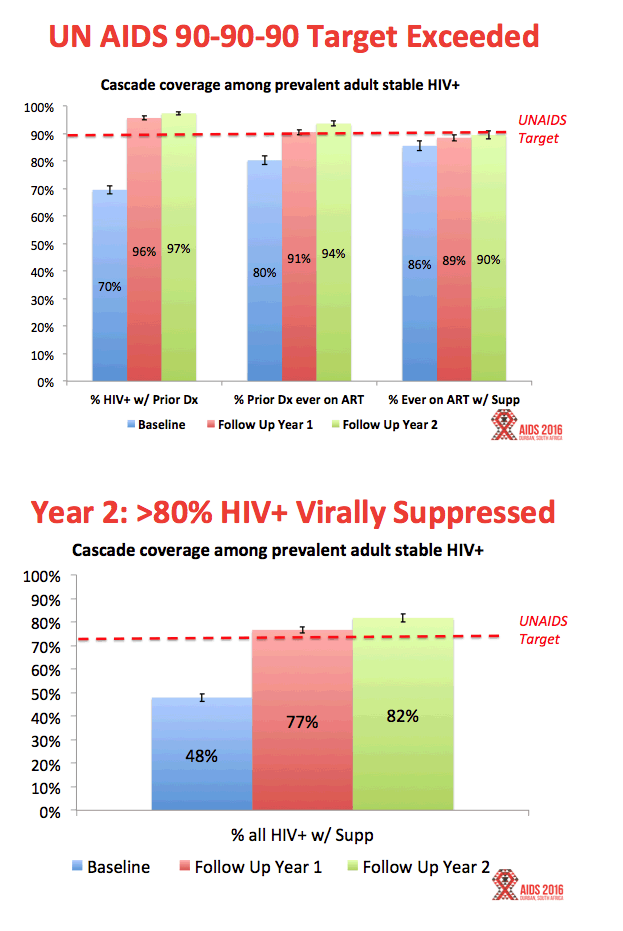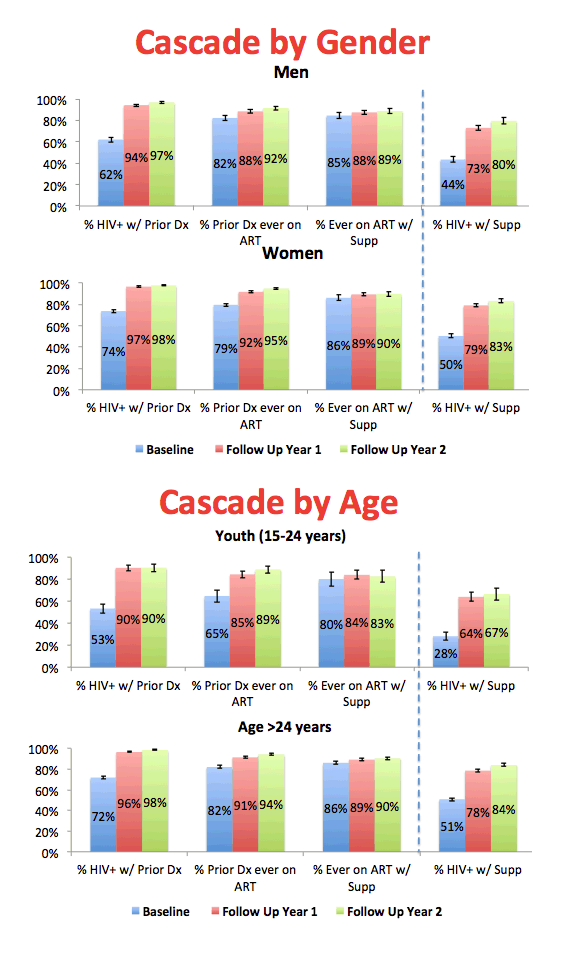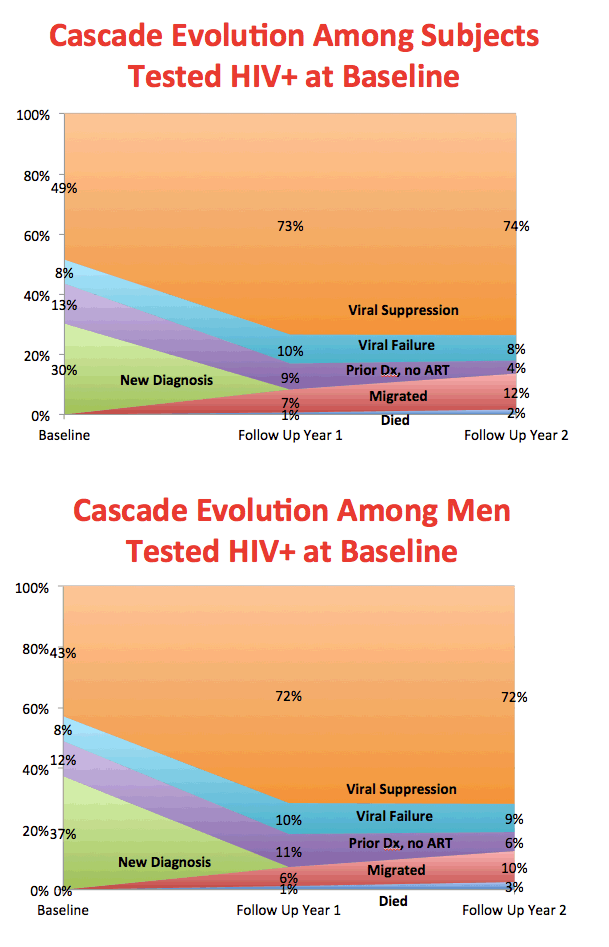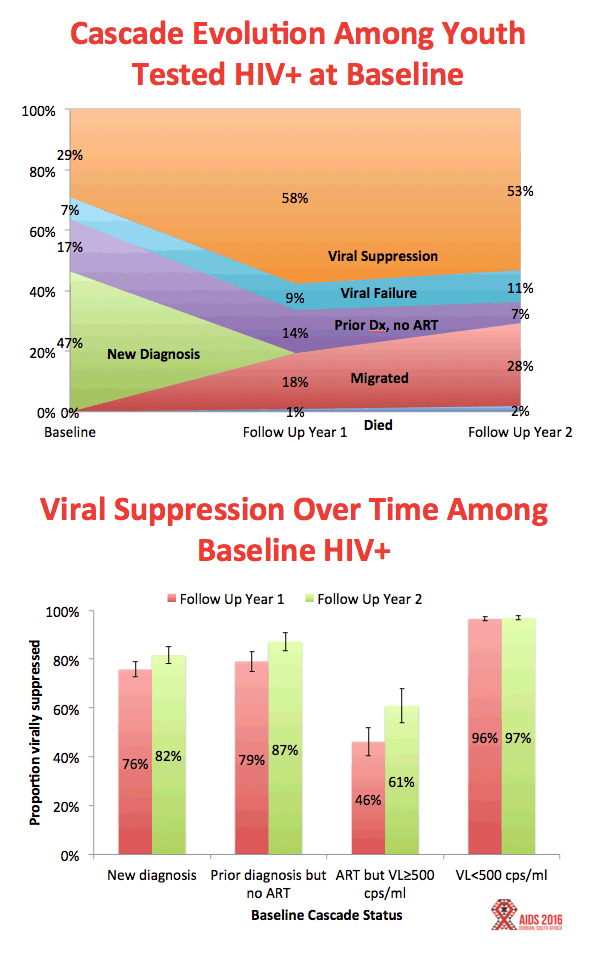 |
 |
 |
| |
Test-and-Treat in Uganda/Kenya Attains 80% HIV Control in 2 Years....
"UN AIDS 90-90-90 Target Exceeded"
|
| |
| |
21st International AIDS Conference (AIDS 2016), July 18-22, 2016, Durban, South Africa
Mark Mascolini
Population-level HIV suppression jumped from 45% to 84% among HIV-positive people during the SEARCH test-and-treat intervention in Kenya and Uganda [1]. That 84% rate exceeds the UNAIDS 73% viral suppression target for everyone with HIV infection [2].
The test-and-treat strategy aims to test everyone at risk for HIV infection and to treat all those who test positive. UNAIDS set test-and-treat goals in its 90-90-90 initiative to diagnose 90% of people living with HIV by 2020, to start antiretroviral therapy (ART) in 90% diagnosed with HIV, and to attain an undetectable viral load in 90% of those treated. Those rates mean 73% of everyone living with HIV will attain viral suppression.
SEARCH is an ongoing cluster-randomized trial to evaluate the test-and-treat approach in 32 Kenyan and Ugandan communities with about 10,000 residents each. The intervention involves annual community-based testing for HIV and other diseases, universal ART eligibility, and streamlined ART linkage and delivery. To reach the 90% testing target, SEARCH promotes community-based, out-of-facility testing through health fairs and home testing. Strategies to reach the 90% treatment target including starting ART at a positive person's first clinic visit. Efforts to attain the 90% viral suppression target include a telephone hotline for patients, appointment reminders by phone call and text messages, and structured viral load counseling.
This analysis aimed to chart progress in attaining test-and-treat targets at baseline census and after 1 and 2 years of follow-up. The study group included people at least 15 years old and living in one of the 16 SEARCH intervention communities more than 6 months in the past year. Health workers determined HIV status and viral load at annual community-based testing events. Researchers used clinic records to determine prior HIV care, including ART.
The SEARCH team focused on 77,773 adults, 45% men, 35% younger than 25, and 10.3% with HIV infection. About half, 53%, were farmers, and 20% were students. Estimating population-level viral suppression (below 500 copies) directly from annual HIV testing data, the researchers determined that suppression rates rose from 45% of HIV-positive people at baseline to 79% after 1 year of follow-up and to 84% after 2 years of follow-up. The 1- and 2-year suppression rates exceed the UNAIDS 73% goal for viral suppression in everyone living with HIV.
Among men, proportions with HIV who attained viral suppression climbed from 44% at baseline to 73% at 1 year and to 80% at 2 years. For women those suppression rates were 50%, 79%, and 83%. Among participants 15 to 24 years old, proportions with HIV who attained viral suppression rose from 28% at baseline to 64% at 1 year of follow-up and to 66% at 2 years. Proportions of HIV-positive people older than 24 with viral suppression rose from 51% at baseline to 79% after 1 year of follow-up and to 84% after 2 years.
Next the researchers figured viral suppression rates according to baseline diagnosis and suppression categories. Among people with a new HIV diagnosis, proportions who attained viral suppression climbed from 76% after 1 year of follow-up to 82% after 2 years. Among people with a prior HIV diagnosis but not on ART, suppression rates rose from 79% after 1 year to 87% after 2 years. Among people on ART at baseline but with a viral load above 500 copies, suppression rates jumped from 46% after 1 year to 61% after 2 years. Among people on ART with a viral load below 500 copies at baseline, 96% retained viral suppression after 1 year and 97% did after 2 years.
The investigators concluded that population viral suppression almost doubled from 45% to 84% during 2 years of the SEARCH intervention. Through 2 years of follow-up, the disparity in viral suppression between men and women lessened, though suppression remained below target in people 15 to 24 years old. The SEARCH team plans to assess the impact of attaining UNAIDS targets on HIV incidence and health, education, and economic outcomes.
References
1. Petersen M, Balzer L, Kwarsiima D, et al. SEARCH test and treat study in Uganda and Kenya exceeds the UNAIDS 90-90-90 cascade target by achieving over 80% population-level viral suppression after 2 years. 21st International AIDS Conference (AIDS 2016). July 18-22, 2016. Durban, South Africa. Abstract WEAC0106LB.
2. UNAIDS. 90–90–90--An ambitious treatment target to help end the AIDS epidemic. October 2014. http://www.unaids.org/en/resources/documents/2014/90-90-90











|
| |
|
 |
 |
|
|